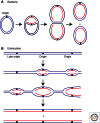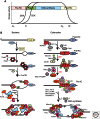Principles and concepts of DNA replication in bacteria, archaea, and eukarya
- PMID: 23818497
- PMCID: PMC3685895
- DOI: 10.1101/cshperspect.a010108
Principles and concepts of DNA replication in bacteria, archaea, and eukarya
Abstract
The accurate copying of genetic information in the double helix of DNA is essential for inheritance of traits that define the phenotype of cells and the organism. The core machineries that copy DNA are conserved in all three domains of life: bacteria, archaea, and eukaryotes. This article outlines the general nature of the DNA replication machinery, but also points out important and key differences. The most complex organisms, eukaryotes, have to coordinate the initiation of DNA replication from many origins in each genome and impose regulation that maintains genomic integrity, not only for the sake of each cell, but for the organism as a whole. In addition, DNA replication in eukaryotes needs to be coordinated with inheritance of chromatin, developmental patterning of tissues, and cell division to ensure that the genome replicates once per cell division cycle.
Figures



References
-
- Araki H 2010. Cyclin-dependent kinase-dependent initiation of chromosomal DNA replication. Curr Opin Cell Biol 22: 766–771 - PubMed
Publication types
MeSH terms
Grants and funding
LinkOut - more resources
Full Text Sources
Other Literature Sources
